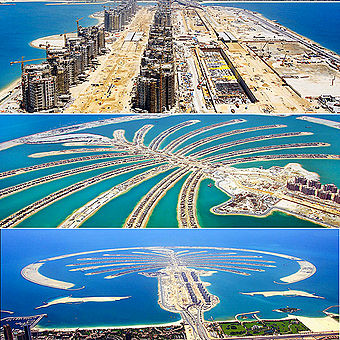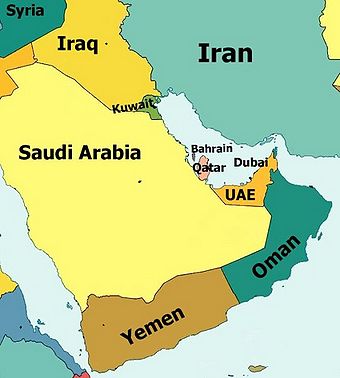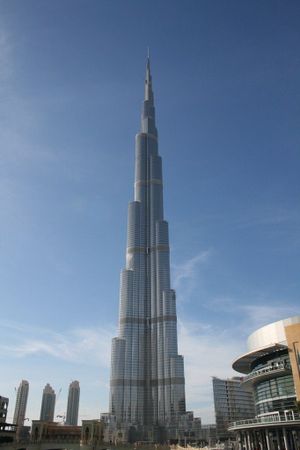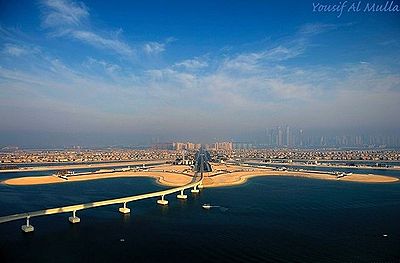Dubai
 From Conservapedia
From Conservapedia 
The city-state of Dubai (Arabic دبيّ) (Dubayy) is a semi- independent country that is one of the seven states that form the United Arab Emirates (UAE) on the Persian Gulf. The UAE handles foreign affairs and defense; Dubai handles its own economic affairs.[1] At 1500 square miles, it is the size of Rhode Island, it is a financial powerhouse, based on borrowed money.[2] It is a monarchy controlled by the absolute rule of a royal family. The population is 1.3 million, of whom 70+% are non-citizens who are temporary workers or very rich Arabs from other nations who maintain luxury second homes here.
Contents
- 1 History
- 1.1 Origins
- 1.2 1930s
- 1.3 Wealth
- 2 Recent
- 3 External links
- 4 Further reading
- 5 References
History[edit]
Origins[edit]
Dubai's origins are largely unknown. It was a very old, small pearl-fishing village when its current rulers, the Maktoum family, took power in 1883. They maintained close ties with Britain. Dubai has been the main entrepôt in the Persian Gulf and the busiest trading port since 1900, with commerce being the main source of revenue for the emirate. The merchant class in Dubai played a key role in restructuring the economy and government decision-making in the pre-oil era of Dubai's development. Today merchants play a fundamental role in economic affairs and the political structure. In addition, again they have taken on roles as service suppliers, urban planners, culture mediators, and internationalists representing the region throughout the world.
1930s[edit]
Dubai suffered economically after 1920 due to the collapse of the pearl industry, the Great Depression of the 1930s, and the loss of extensive trade networks during World War II. Until the surge of oil revenues in the late 1960s, political instability and merchant unrest existed and constituted an organized attempt to subvert British control and the ruling Al-Maktoum family. African slavery was practiced until the 1960s. The uprising of 1938 in Dubai was the culmination of a decade of grievances and minor rebellions against the autocratic rule of Shaykh Sa'id bin Maktum (ruled 1912-58). In the 1930s the Trucial Coast was characterized by great poverty resulting primarily from a decline in the pearl trade. Much of the initiative for reform sprang from an attempt to ameliorate economic conditions—the leaders of the movement having previously been successful pearl merchants. The new government established in October 1938 lasted only a few months before Shaykh Sa'id with Bedouin support was able to overthrow it in March 1939. The collapse of the reform movement is attributable to the role played by British agents and the weakness of the political structure that was set up. Until 1979, angry border dispued with Abu Dubai simmered on and off, verging on warfare.

Wealth[edit]

In 1966 the discovery of oil brought vast wealth to the Trucial States (UAR). Dubai is small and has limited oil reserves, so its rulers turned to the merchants. Starting in the 1980s, crown prince Sheik Mohammed bin Rashid al-Maktoum, refashioned Dubai into a free-trade oasis. It opened a tax-free infotech hub, Dubai Internet City, in 2000, to attract technology companies; media, finance and maritime projects soon followed. Dubai deliberately followed a path of extensive trade, tourism, and open-society development. This has entailed very rapid growth, great wealth, and liberal policies toward liquor (but with strong criminal penalties for homosexuality).
Thanks to massive spending and borrowing by its state-owned development companies, Dubai became a global financial center in the 1990s. It built the sail-shaped Burj al-Arab, the most expensive hotel in the world, and the unfinished 160-story Burj Dubai, the world's tallest building. Its coastline has been lined with man-made islands shaped to represent a date palm and a map of the world. The government is one of business-oriented paternalistic rule, strong development vision, a lean and efficient state apparatus, active market interference, and a reliance on market mechanisms, there are strong ties between the public and the private sectors.
Recent[edit]
The world Financial Crisis of 2008 has left Dubai staggering. Many very expensive luxury investments around the world went sour, often losing 50% to 90% of their value; real estate prices dropped 50% and new construction ended. Dubai is hard pressed to repay its debts but Sheik Mohammed has downplayed the rising debt, which some estimate to be more than 100% of GDP. Despite a $15 billion bailout from neighboring Abu Dhabi (which has oil) i late 2009, the crisis continues to mount.

External links[edit]
- Time magazine
Further reading[edit]
- Davidson, Christopher M. "Arab Nationalism and British Opposition in Dubai, 1920-66," Middle Eastern Studies 2007 43(6): 879-892, in EBSCO
- Hvidt, Martin. "Public-Private Ties and Their Contribution to Development: the Case of Dubai," Middle Eastern Studies 2007 43(4): 557-577, in EBSCO
References[edit]
- ↑ The UAE was formerly called the "Trucial States"
- ↑ It has a small amount of oil but less than 6% of its GDP comes from petroleum sales. see GDP
Categories: [Asian Cities and Towns] [Middle Eastern Countries]
↧ Download as ZWI file | Last modified: 02/06/2023 10:58:02 | 96 views
☰ Source: https://www.conservapedia.com/Dubai | License: CC BY-SA 3.0
 ZWI signed:
ZWI signed: KSF
KSF